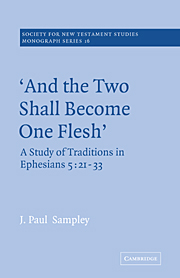Book contents
- Frontmatter
- Contents
- Dedication
- Preface
- Acknowledgments
- I Introduction of problem and perspective
- II Outline of the epistle to the Ephesians and the author's knowledge of his readers
- III Identification and study of traditional materials in 5: 21–33
- IV Three passages from the homologoumena especially related to 5: 21–33
- V Hermeneutical problems in 5: 31–2
- VI The movement of thought in 5: 21–33
- VII Detailed analysis of 5: 21–33
- VIII Concluding observations
- Bibliography
- Indexes (passages cited, authors, subjects, selected Greek words)
I - Introduction of problem and perspective
Published online by Cambridge University Press: 29 September 2009
- Frontmatter
- Contents
- Dedication
- Preface
- Acknowledgments
- I Introduction of problem and perspective
- II Outline of the epistle to the Ephesians and the author's knowledge of his readers
- III Identification and study of traditional materials in 5: 21–33
- IV Three passages from the homologoumena especially related to 5: 21–33
- V Hermeneutical problems in 5: 31–2
- VI The movement of thought in 5: 21–33
- VII Detailed analysis of 5: 21–33
- VIII Concluding observations
- Bibliography
- Indexes (passages cited, authors, subjects, selected Greek words)
Summary
In recent years, studies in Ephesians have begun to enter into a new phase. Previous investigations of the epistle were dominated by questions of authenticity, relation to Colossians and the homologoumena and by dogmatic inquiries into themes that by historical accident occur in Ephesians. The newer approach to the study of Ephesians is dominated primarily by the hypothesis that the document is a unique, syncretistic collection of a variety of traditions extant in the early church. Ernst Käsemann has clearly posited this viewpoint in his insistence that Ephesians be understood as a mosaic of early Christian traditions and conventions that reach far beyond a compilation of fragments from the Pauline homologoumena. As Käsemann puts it: ‘The entire letter appears to be a mosaic composed of extensive as well as tiny elements of tradition, and the author's skill lies chiefly in the selection and ordering of the material available to him.’ While recognizing that the Ephesian mosaic is complex and composed from sources more diverse than the homologoumena, more recent contributions to the study of Ephesians have attempted to assess not only the origin and extent of the traditions incorporated in Ephesians but also the new messages and purpose conveyed through this association of diverse materials. Studies of a dogmatic or thematic nature, however, properly continue, although, in and of themselves, they contribute little to the advancement of the study of Ephesians.
- Type
- Chapter
- Information
- 'And The Two Shall Become One Flesh'A Study of Traditions in Ephesians 5: 21-33, pp. 1 - 5Publisher: Cambridge University PressPrint publication year: 1971



